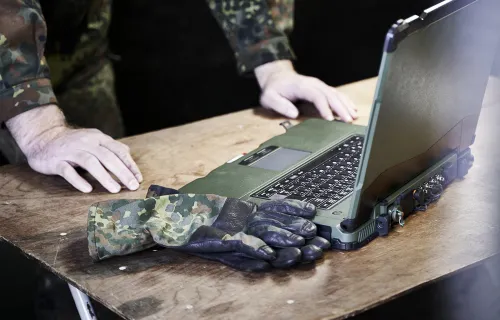How are defense and intelligence organizations using cybersecurity, AI and modernization to drive resiliency, efficiency and other strategic outcomes? In this video, we explore insights from the 2025 CGI Voice of Our Clients research, based on in-depth interviews with 70 defense and intelligence leaders, on the priorities and challenges shaping their industry.
From responding to geopolitical volatility, to accelerating digital transformation, to reconfiguring supply chains, defense and intelligence leaders are navigating rising complexity through digital strategies and solutions.
Key trends covered in this video include:
- Geopolitical shifts and volatility
- Accelerated digital transformation
- Supply chain reconfiguration
- Aging workforce and talent shortages
- Rise of disruptive technologies
Learn from real-world examples that highlight how defense and intelligence organizations are using AI and other disruptive technologies to enhance decision-making, situational awareness and operational agility.
At CGI, we help defense and intelligence leaders digitally transform and modernize their operations to address fast-changing trends and priorities and achieve desired business outcomes.
Video transcript
- Global trends reshaping defense and intelligence
-
Global developments are reshaping defense and intelligence priorities, creating a demand for robust supply chains, better operational strategies, strengthened resilience and faster innovation.
Defense and intelligence leaders are embracing the total defense mindset, focusing on cross-domain collaboration. They're aligning the military authorities with agencies of energy, transport, healthcare, as well as the private sector in order to keep critical services running and embedding resilience into everyday operations.
Our Voice of Our Clients research, based on interviews with 70 industry leaders, reveals that digital transformation is the top IT priority for 73% of leaders, with AI, cybersecurity and cloud being key investment areas. This focus is intersecting with a critical shortage of skilled and experienced talent, particularly in specialized fields, demanding a new approach to protect ongoing digital transformation and mission readiness.
To stay ahead, the industry must modernize infrastructure, reinforce the defense industrial base, and secure the talent needed to keep mission-critical systems operational.
- Key industry shifts driving innovation and resilience
-
Intelligence leaders are responding to growing complexity through faster innovation, stronger resilience, and new ways of delivering missions.
A significant trend is geopolitical shifts and volatility. Nations are increasing defense budgets to address growing political tensions and regional conflicts. Nearly 70% of leaders cite changing political and regulatory environments as a key macro trend impacting their organizations. Decision-makers are rethinking their procurement strategies, alliances, partnerships, and focus areas.
We also see that digital transformation is accelerating across the industry. Advanced digital tools are supercharging the OODA Loop, helping commanders make better decisions faster. With correct information at hand, secure cloud-native platforms and edge-processed sensor feeds receive and transmit mission-critical data to frontline units in seconds, increasing operational agility.
Another impactful trend is supply chain reconfiguration. Onshore manufacturing, stockpiles of key components, and diversified supplier networks with end-to-end visibility are becoming critical to maintaining resiliency. New production methods like additive manufacturing and modular assembly lines enable rapid capacity increases and shift reconfiguration of output.
With an aging workforce and talent shortages, the industry faces critical talent gaps. With 85% of leaders having difficulties recruiting IT talent, organizations are investing in training programs and partnering with universities and the private sector to attract and keep talent with high demand skills.
The sector faces a growing talent gap with aging workforce and intense competition for talent, especially in the cyber and AI domains. To close the gap, organizations are expanding recruitment beyond traditional channels. This helps tapping into civilian tech talent using reservists and dual use skills from the industry. New educational pathways, including academic collaborations are accelerating onboarding, especially in the mission-critical areas like data fusion and autonomous systems.
The rise of disruptive technologies is a significant trend—one that is helping leaders overcome challenges as AI-driven analytics, autonomous systems and space-based sensors enhance situational awareness and autonomy. Venture-backed defense tech start-ups are reshaping the innovation landscape to deliver scalable, next-generation capabilities.
- Cybersecurity and national security as top business priorities
-
Industry leaders tell us that their top two business priorities are enhancing cybersecurity measures and enhancing national security defense capabilities.
We see that vital networks are being hardened with cybersecurity measures, and there is investment in strategic stockpiles of key components, which ties to local suppliers as backup plans when disruption strikes.
- AI-powered transformation in a multinational defense organization
-
Faced with pressure to deliver real-time decision support, enable collaboration across nations, and adapt rapidly in complex operational environments, a leading multinational defense organization set out to rethink how critical information flows across its operations.
With our support, they introduced AI FELIX, an AI assistant that automatically summarizes, organizes, and routes incoming communications using natural language processing and generative AI. The assistant securely manages vast volumes of mission-critical information.
Within six months, the organization reduced analyst workload by up to 60%, improved operational coordination, and strengthened its ability to act quickly across complex multi-domain environments.
By integrating trusted AI into mission workflows, leaders gained faster insights, sharper priorities, and greater resilience in a rapidly changing world.
- Accelerating defense innovation through agile procurement
-
Whoever masters, observes, orients, decides, acts faster comes out on top. Data-driven solutions, as we find in our discussions, they really are about speed. Speed here really is a thing and data supports a faster run-through in the OODA Loop.
Leaders of defense and intelligence organizations must rethink acquisition and procurement to unleash the innovation at the front line by adopting agile sprint processes and giving war fighters direct input into the design and testing of products and systems. New capabilities can reach the field faster, cutting procurement and production cycles from years to months or even weeks. The supporting technology for that exists today.
- Building a resilient, future-ready defense ecosystem
-
Our research demonstrates that resilience is no longer a static goal. It's a moving target that demands speed, agility, and trusted collaboration. Defense and intelligence leaders must act with urgency, modernizing infrastructure, accelerating capabilities, and securing critical talent.
Tomorrow's leaders should focus on moving from siloed supply chains to interconnected supply ecosystems. Build resilience with citizens in mind, connecting innovation directly to operational readiness, and creating flexible talent pipelines with multiple skills.
Now is the time to act to ensure a safer, stronger tomorrow.




